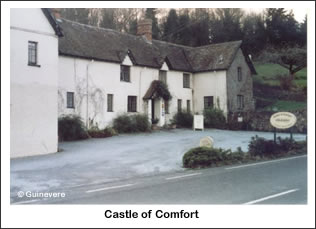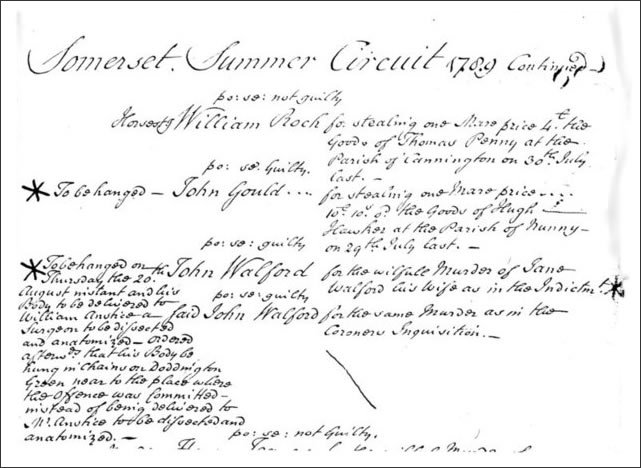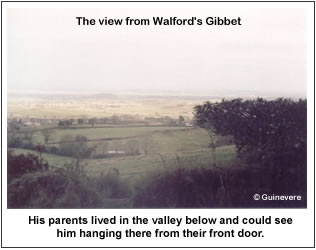Baptised 1762, hanged and gibbeted in 1789, John Walford was born in the Parish of Over Stowey in the depths of the Quantock Hills in Somerset. He was from a respectable family. His father William had a small business as a collier and charcoal burner which he sold in local villages.

John burned charcoal for his father in a charcoal burner’s hut. It was a hard life, he couldn’t sleep for longer than a few hours at a time because the wood had to be turned constantly. He was a popular man locally, particularly with the diarist, Thomas Poole, who he had befriended as young boy.
Thomas Poole wrote about John, as did Wordsworth and Coleridge, who also lived in the village. Poole described John Walford thus –
“……. athletic, nimble and strong. He had a fine countenance, but certainly of the saturnine order – dark hair an eyebrows; dark sparkling eyes……. He was a favourite of all……..remarkable for good temper and generosity but he possessed ardent feelings and strong passions…..”
He was particularly popular with Jane Shorney, described by Poole as a poor stupid creature, almost an ideot …. an ordinary squat person, disgustingly dirty and slovenly in her dress
Jane used to visit John in his hut and in 1785 declared to the Overseers of the Poor of the parish that she was pregnant and that John was the father. The Overseers had the power to have John imprisoned if he refused to marry Jane or take responsibility for the child. John’s mother Ann agreed to provide for the child on his behalf. The following year Jane bore another illegitimate child, this time by John’s brother William, who agreed to provide for the child but not to marry Jane. John had moved on with his life and was now courting Ann Rice, the daughter of the local miller.
He was still spending long lonely nights in the charcoal burner’s hut and Jane Shorney again came calling. She declared herself pregnant and the Overseers were obliged to arrest John once more. Pride, or maybe the feeling that she wouldn’t be sympathetic, prevented him from asking his mother for help and he did not have the money to pay for the child. His choice was matrimony or prison.
The marriage was doomed from the start. Ten days later John was overheard in the pub making plans to abscond to London with a friend to make a new start.
He returned home to Jane who asked him for a shilling to go to the Castle of Comfort for some cider. He gave her the shilling and agreed to go with her. Along the way an argument developed and John lost his temper and lashed out knocking Jane unconscious. He panicked and tried to drag her to a nearby shaft of a copper mine but she was too heavy. Afraid of discovery he cut her throat and quietly returned to his cottage.

Jane’s body was discovered the next morning. John denied everything but the knife was discovered in his cottage, as were his freshly washed clothes. He was arrested and taken to Ilchester jail to await his trial at Bridgwater Assizes. The verdict from the jury was inevitable, despite the many friends who spoke up for John during his trial.
The jury petitioned the judge for a public hanging and the request was granted and John’s body was to be “hung in chains”, ie gibbeted in an iron cage.
That night in the condemned cell John’s brother, William, begged him to confess and make his peace with God. This he did, but said it was not premeditated, “The Devil got into my head”.

On Thursday August 30th 1789 John Walford was chained hand and foot and lifted onto a cart which was to take him to the place of execution. Beside him lay the cage in which his body was to be placed. When they arrived at Nether Stowey a message came to delay the procession for an hour as the gallows were not ready. John was taken into The Globe Inn where he was given bread and a mug of ale by the landlord. Many people crowded in to see him and he drank a toast to them saying, “Here is to all of your healths and the blessing of God be with you all.” He shook hands with Tom Poole who had been a prosecution witness.
As he got back on the cart Ann Rice, pregnant with his child, ran out from the crowd and climbed onto the cart to say her goodbye to him. She had to be removed by the Peace Officers.
The procession continued to Danesborough Hill where the gallows had been erected beside a 30ft pole for the gibbet.
When the cart stopped below the gallows John asked if he could see Ann again. Word spread through the crowd and she was found and brought to the cart faint and exhausted. He talked to her for a few minutes and bent to kiss her but was prevented from doing so by an officer who pulled her away. He grabbed her hand and kissed it and tears fell from his eyes. He pulled himself together then said that he was ready.
The vicar began the prayers and John joined in loudly with the Lord’s Prayer. A board was placed across the cart and the noose around his neck. John mounted the board and told the crowd that he was guilty of the crime and that he hoped that God and the world had forgiven him. He was given a handkerchief to drop when he was ready and the hood was put over his head. He composed himself for a few seconds then jumped from the board, dropping the handkerchief at the same time. The cart was pulled away and John Walford hanged.
A year afterwards the iron cage containing his body fell from the pole and he was buried by sympathetic locals.
John was first cousin of my ancestor Elinor Walford.
Guinevere
© Guinevere 2008
SOURCES
The writings of Thomas Poole (various)
The Times Newspaper
Transcript of the trial held at Somerset Record Office
Original trial papers held at The National Archive (ASSI 24)
Parish Records and Parish Chest Papers held at Somerset Record Office
“A Quantock Tragedy” ~ David Worthy
“In Quantock Country” ~ Berta Lawrence
